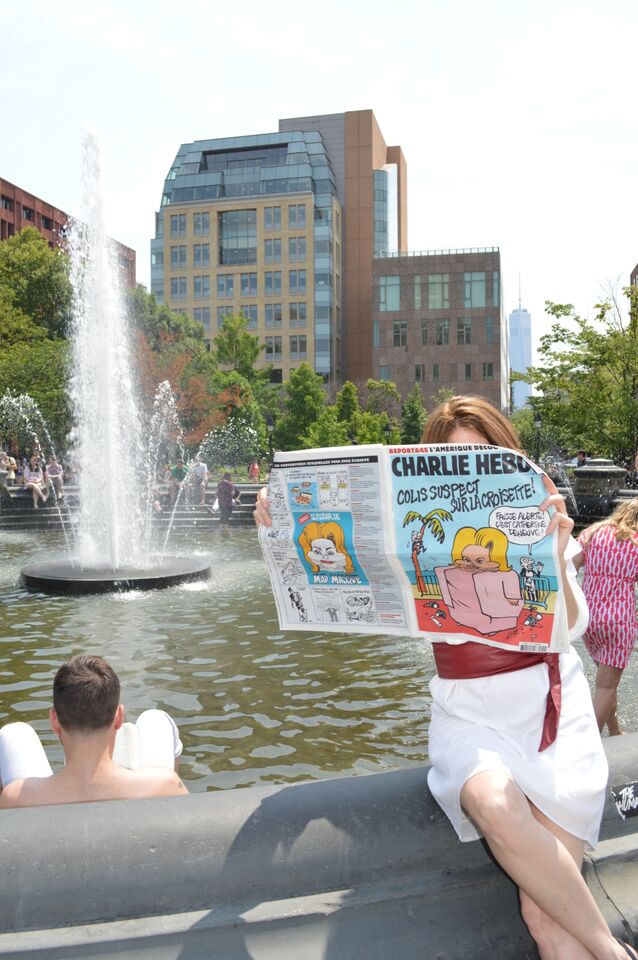Last week, we featured an article about the e-mag Creativity Is Risky: Free Speech in a Charlie Hebdo World, published by Manhattan resident Sally O’Dowd to raise awareness about the persecution of writers and cartoonists around the world.
A tribute to the 11 Charlie Hebdo journalists murdered in January by two Al Qaeda terrorists, Creativity Is Risky reminds us how easy free speech can be whittled away. While writers in the West are curbing Internet searches for fear of government retaliation, Saudi blogger Raif Badawi is getting lashes in Jeddah.
While the magazine’s articles cover a wide range of intersecting issues related to free speech, the original photography is a story in and of itself. Creativity Is Risky art director and photographer Michelle Zapata guides us through it. You’ll never take graffiti for granted again.
What got you involved in this project?
I was completely crushed when I heard the news of the Charlie Hebdo tragedy. These murders were such a violation of freedom of speech, freedom of expression, freedom in all its ways. When talking with Sally about her editorial direction, I saw the opportunity to showcase an objective visual that could be touching and also deep in its creative expression.
What was your creative vision?
I wanted to combine various elements and viewpoints from different communities while taking people on a virtual walking tour of New York City. Such is the beauty of the Freedom Tower as it stands tall behind Washington Square Park – the focal point of our cover –or the photo of the Muslim prayer rug at the Met, which accompanies Sally’s piece about multicultural understanding and tolerance. Further downtown, graffiti became a big player.
Why graffiti?
For many years, graffiti has widely been considered vandalism – less so today but the stigma is still there. It is one of the rawest forms of expression and art. In the height of the fight against graffiti, people were arrested, beaten, fined and in some instances artists had physical fights with each other. We have since come a long way. We now have places internationally that are dedicated to showcasing these amazing artists. From coast to coast, communities celebrate this form of expression. This was an art form that many people paid for dearly to pave the way to acceptance and appreciation. In this way, graffiti is like Charlie Hebdo’s satire.
Different snippets from a mural appear throughout the magazine. What’s the story behind that?
That was a terrific find! The mural is north of Houston and signed by a Mr. Must Art. Two NYU students who said they were on their way to the library stopped to let me photograph them reading Charlie Hebdo.
This enormous piece of art serves as a metaphor for many themes in the magazine. The bird is a natural complement to Sally’s epigraph celebrating the “deathless inspiration” of the phoenix and its capacity for vision – the very same traits shared by writers and artists. The baby represents hope, while phrases such as “the world is ours” and “love, peace and universal blessings” remind us to respect other people’s right to free speech while also reminding us that we have the power to choose how we want to live with one another. The many faces and eyes in the mural, coupled with the phrase, “keep your eyes open” serve as a metaphor for government surveillance, which we talk about in the latter part of the magazine.
We noticed the prevalence of the Protect Your Magic sticker and the Protect Yo Heart stencil. Are stickers and stencils emerging as another street form? Yes, stickers are becoming quite popular among young artists because they are inexpensive to produce and easy to place around town. Stencils have been used for years although they are still considered vandalism. We happened across “Protect your magic” and “Protect yo heart” throughout the day – we couldn’t have dreamed up a better way to summarize the magazine’s free speech mantra. We continue to find the Protect Yo Heart stencil in a variety of colors all over the city. For us, it’s a good omen.
What is the message you want people to walk away with?
The only way to eradicate ignorance is through education, and that was Sally’s main goal. She wanted to educate people about the threats to free speech in general and also ask people to know the facts underlying a satirist’s work. It was my hope to illustrate and support the stories with interesting visuals that would make people think beyond the obvious, which is exactly what satire aims to do. All of the images I shot for Creativity Is Risky were with the idea of bringing awareness to an unjust situation. If we silence our creativity or forms of expression because of someone’s discontent we will limit our divine potential. Let’s stop placing limits on our freedoms and celebrate our expressions of it! Let’s learn acceptance and tolerance worldwide. Let’s evolve.
How can people support your message?
People can find the magazine at www.sallyodowd.com and click on the link to Creativity Is Risky: Free Speech in a Charlie Hebdo World. They can share the entire publication or a specific article. They are welcome to comment on Sally’s site and share their views on their social channels using #freespeech and #creativityisrisky hashtags. Sally tweets from @sallyodowd and her public Facebook page is Sally On Media – those are good places to stay up to date on the issue.
For more info and to share content, please visit O’Dowd’s blog, Twitter andFacebook.




